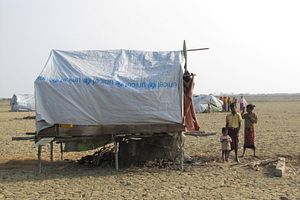This article is part of “Southeast Asia: Refugees in Crisis,” an ongoing series by The Diplomat for summer and fall 2015 featuring exclusive articles from scholars and practitioners tackling Southeast Asia’s ongoing refugee crisis. All articles in the series can be found here.
The Asian region is host to the largest number of refugees, asylum seekers, and internally displaced people in the world. Yet a broad absence of asylum policy at regional and domestic levels means that the region is ill-equipped to effectively respond to this problem.
This Asian asylum policy vacuum is the legacy of a long-standing antipathy towards the international refugee protection regime on the part of many Asian states, and a failure to adopt a regional approach to the issue. In early 2015, the Rohingya refugee crises challenged the region on the matter of this failure, and highlighted the devastating human effects of the absence of effective asylum policy.
The Asian asylum policy vacuum occurs on various policy levels. Asia has the fewest signatories to the Refugee Convention. Unlike Central America, Africa, or the Middle East, it has not formed its own region-wide protection frameworks to complement international law. Asian states generally prefer bilateral solutions, yet on this matter the region has the smallest number of formal bilateral or multilateral agreements. Similarly, on the level of state policy, many states have no policy on forced migration at all, and instead respond to refugees as an unauthorized migration issue.
The lack of support for the Refugee Convention from Asian states can be explained by the Eurocentric focus of the Convention at its time of creation. European states reeling from the Second World War, and others further afield, came together in an unprecedented way to address the problem of mass displacement. What came to be known as the Refugee Convention was drafted in a series of conferences in 1949 and 1950. Most Asian states were absent from the proceedings, however, and those who did take part expressed a sense of frustration that their contributions were marginalized.
At the same time as the Convention was being discussed in the meeting rooms of Europe, vast displacement was occurring throughout Asia: in 1947 an estimated 14 million people were displaced by the partition of India and Pakistan; in 1948 the establishment of Israel led to an exodus of 700,000 Palestinians; in 1950, 7 million North Koreans sought sanctuary in the South. Many Asian states felt that the Refugee Convention did not provide a solution or strategy for dealing with these situations, and worried that it placed undue burden on fledgling states barely able to provide for their own populations. Moreover, displacement in Asia was most often the result of the social and political change triggered by decolonization. In other words, these forced migrants did not fit the definition of refugee status agreed upon in Geneva.
Responses to the current Rohingya crisis illustrates a continued ambivalence towards refugees by many Asian states. China, who accommodates ethnic Chinese refugees but restricts access to the UNHCR, has declined to intervene when it comes to the more “politically costly” Rohingyas. India has absorbed groups of refugees in the past, including Rohingyas, but has been careful not to be involved on a political level. Japan is the world’s fourth largest donor to the UNHCR, but in 2014 resettled only 11 refugees. In response to the Rohingya crisis, Japan pledged $3.5million, but would not offer resettlement places.
Malaysia and Indonesia has agreed to offer temporary shelter to 7,000 Rohingya refugees. But Malaysia has hosted approximately 75,000 Rohingya refugees for many years before the current crisis, yet has no refugee law that might grant them healthcare, education or work rights, and implements regular crackdowns on “unauthorized migrants” resulting in detention, caning, and expulsion. Indonesia has traditionally been tolerant of the fewer refugees in its community, but within the last decade it has incrementally tightened its borders, including accepting Australian funding and support to open a network of detention centers, in which it detains asylum seekers indefinitely. Indonesia and Australia co-chair the Bali Process, the most recent attempt at a regional agreement on matters including asylum, but which sadly has been ineffective on the recent crisis.
Clearly, a region-wide coordinated response is required to address the gap. As the dominant intergovernmental organization in Southeast Asia, ASEAN has an important role to play. Established in 1967 as a forum for establishing trade cooperation and fostering regional stability, it has slowly extended its mandate to include some social issues. For the most part, however, twin principles of “good neighborliness” and “non-interference” have been central to ASEAN’s mode of operating. These principles manifest as a reluctance on the part of ASEAN members to involve themselves in what it regards as the internal sovereign matters of member states.
After many years of rejecting the notion that it had a role to play in human rights, ASEAN finally adopted a Human Rights Declaration in 2012. On refugees, Article 16 of the Declaration states that “Every person has the right to seek and receive asylum in another State in accordance with the laws of such State and applicable international agreements.” The principle of non-interference thus remains. It is still early in the lifespan of the ASEAN Human Rights Declaration, so we are yet to see how Article 16 might play into states responses to forced migrants in the region. In the meantime, the Rohingya and other refugees in the region face significant challenges in their search for effective and durable protection.
Dr. Amy Nethery is a lecturer in Politics and Policy Studies at Deakin University, Melbourne, Australia. She researches asylum policy in Australia and Asia. Her most recent publication (with SJ Silverman) is Immigration Detention: The Migration of a Policy and it’s Human Impact (Routledge 2015).

































